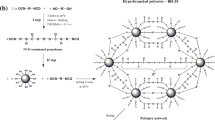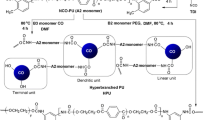Abstract
To prepare a pre-polymer in this study, the following materials were used: 4,4′-diphenylmethane diisocyanate, poly(ε-caprolactone) diol (PCL), and polytetramethylene ether glycol. The pre-polymer was then cured using H2O to form a new type of polyurethane (PU), PCL/H2O-PU. Fourier transform infrared analysis confirmed the successful synthesis of PCL/H2O-PU. Results from thermal gravimetric analysis, differential scanning calorimetry, and dynamic mechanical analysis showed that the thermal resistance and glass transition temperature of PCL/H2O-PU increased with the H2O and the hard segment content. Stress–strain curves for the PCL/H2O-PU specimens showed that with increasing H2O content, the tensile strength and Young’s modulus increased, but the elongation at break decreased. WAXD patterns indicated that with a higher H2O content, the polymer chains were in a more ordered arrangement, although the morphology was still amorphous. The degree of swelling in an aqueous ethanol solution and the hydrolytic degradation rate increased with the PCL content. Scanning electron microscopic images showed that during the degradation period, the original wrinkled surface of PCL/H2O-PU became smooth, and then cracks were formed. The cracks became more severe when the degradation was at a higher temperature.










Similar content being viewed by others
References
Ni H, Skaja AD, Soucek MD (2000) Acid-catalyzed moisture-curing polyurea/polysiloxane ceramer coatings. Prog Org Coat 40:175–184
Gardner G (1996) Moisture-curing polyurethanes. J Prot Coat Linings 13:81–100
Chattopadhyay DK, Prasad PSR, Sreedhar B, Raju KVSN (2005) The phase mixing of moisture cured polyurethane-urea during cure. Prog Org Coat 54:296–304
Chattopadhyay DK, Sreedhar B, Raju KVSN (2006) The phase mixing studies on moisture cured polyurethane-ureas during cure. Polymer 47:3814–3825
Yukihiro N, Sato A, Sato S, Mori H, Endo T (2007) Synthesis of novel moisture-curable polyurethanes end-capped with trialkoxysilane and their application to one-component adhesives. J Polym Sci, Part A: Polym Chem 45:2689–2704
Ren D, Frazier CE (2012) Wood/adhesive interactions and the phase morphology of moisture-cure polyurethane wood adhesives. Int J Adhes Adhes 34:55–61
Datta J (2008) Rohn M, Structure, thermal stability and mechanical properties of polyurethanes, based on glycolysate from polyurethane foam waste, prepared with use of 1,6-hexanediol as a glycol. Polimery 53(11–12):871–875
Datta J (2010) Synthesis and investigation of glycolysates and obtained polyurethane elastomers. J Elastom Plast 42(2):117–127
Datta J, Kacprzyk M (2008) Thermal analysis and static strength of polyurethanes obtained from glycolysates. J Therm Anal Calorim 93(3):753–757
Datta J, Janicka M (2007) Synthesis and properties of polyurethanes made of secondary raw materials. Przemysł Chemiczny 86(7):624–626
Modesti M, Lorenzetti A (2002) Flame retardancy of polyisocyanurate-polyurethane foams. Use of different charring agents. Polym Degrad Stab 78(2):341–347
Tsou CH, Suen MC, Yao WH, Yeh JT, Wu CS, Tsou CY, Chiu SH, Chen JC, Wang RY, Lin SM, Hung WS, De Guzman M, Hu CC, Lee K-R (2014) Preparation and characterization of bioplastic-based green renewable composites from tapioca with acetyl tributyl citrate as a plasticizer. Materials 7(8):5617–5632
Tsou CH, Hung WS, Chen JC, Huang CY, Wu CS, Chiu SH, Tsou CY, Chen JC, Chu CK, Hu CC et al (2014) New composition of maleic-anhydride-grafted poly(lactic acid), rice husk with methylenediphenyl diisocyanate. Mater Sci Medžiagotyra 20(4):446–451.14
Tsou CH, Kao BJ, Suen MC et al (2014) Crystallization behavior and biocompatibility of poly(butylene succin-ate)/poly(lactic acid) composites. Materi Res Innov 18:372
Hatakeyama T, Izuta Y, Hirose S, Hatakeyama H (2002) Phase transitions of lignin based polycaprolactones and their polyurethane derivatives. Polymer 43:1177e82
Wang W, Ping P, Chen X, Jing X (2006) Polylactide-based polyurethane and its shape-memory behavior. Eur Polym J 42:1240–1249
Lee SI, Yu SC, Lee YS (2001) Degradable polyurethanes containing poly(butylene succinate) and poly(ethylene glycol). Polym Degrad Stab 72:1–87
Guan J, Sacks MS, Beckman EJ, Wagner WR (2004) Biodegradable poly(ether ester urethane)urea elastomers based on poly(ether ester) triblock copolymers and putrescine: synthesis, characterization and cytocompatibility. Biomaterials 25:85–96
Moore T, Adhikari R, Gunatillake P (2005) Chemosynthesis of bioresorbable poly(g-butyrolactone) by ring-opening polymerisation: a review. Biomaterials 26:3771–3782
Yeganeh H, Jamshidi H, Jamshidi S (2007) Synthesis and properties of novel biodegradable poly(ε-caprolactone)/poly(ethylene glycol)-based polyurethane elastomers. Polym Int 56:41–49
Heijkants GJC, Calck RV, Tienen TG, Groot JH, Buma P, Pennings AJ, Veth PH, Schouten AJ (2005) Uncatalyzed synthesis, thermal and mechanical properties of polyurethanes based on poly(ε-caprolactone) and 1,4-butane diisocyanate with uniform hard segment. Biomaterials 26:4219–4228
Woo GLY, Mittelman MW, Santerre JP (2000) Synthesis and characterization of a novel biodegradable antimicrobial polymer. Biomaterials 21:1235–1246
Hatakeyama T, Izuta Y, Hirose S, Hatakeyama H (2002) Phase transitions of lignin-based polycaprolactones and their polyurethane derivatives. Polymer 43:1177–1182
Lamba NMK, Woodhouse KA, Cooper SL (1998) Polyurethanes in biomedical applications. CRC Press, Boca Raton
Sarkar D, Yang JC, Lopina ST (2008) Polymer/carbon nanotube nanocomposites via noncovalent grafting with end-functionalized polymers. J Appl Polym Sci 108:2345–2351
Sarkar D, Yang JC, Gupta AS, Lopina ST (2009) Synthesis and characterization of L-tyrosine based polyurethanes for biomaterial applications. J Biomed Mater Res A 90(1):263–271
Shah PN, Manthe RL, Lopina ST (2009) Electrospinning of l-tyrosine polyurethanes for potential biomedical applications. Polymer 50:2281–2289
Shah PN, Yun YH (2012) Cellular interactions with biodegradable polyurethanes formulated from L-tyrosine. J Bio Appl 0:1–15
Tsou CH, Lee HT, Tsai HA, Cheng HJ, Suen MC (2013) Synthesis and properties of biodegradable polycaprolactone/polyurethanes by using 2,6-pyridinedimethanol as a chain extender. Polym Degrad Stab 98:643–650
Lee HT, Tsou CH, Jou CH, Huang FC, Wang ML, Suen MC (2014) The effects of silver nitrate on the structure and properties of polyurethanes containing pyridyl units. Polym Bull 71:2749–2767
Acknowledgments
The authors express their appreciation to Everlight Chemical Industrial Corporation, Far Eastern New Century Corporation, Apex Nanotek Corporation, Grabio Greentech Corporation, Ching-Yung Trading Co. Ltd., Fabric King Textile Co. Ltd., the Ministry of Economic Affairs (100-EC-17-A-10-S1-186), and the National Science Council (NSC 102-2221-E-161-011, NSC 100-3113-E-033-001, and NSC 102-2221-E-003-065) for supporting this work.
Author information
Authors and Affiliations
Corresponding author
Rights and permissions
About this article
Cite this article
Tsou, CH., Lee, HT., De Guzman, M. et al. Synthesis of biodegradable polycaprolactone/polyurethane by curing with H2O. Polym. Bull. 72, 1545–1561 (2015). https://doi.org/10.1007/s00289-015-1356-x
Received:
Revised:
Accepted:
Published:
Issue Date:
DOI: https://doi.org/10.1007/s00289-015-1356-x




